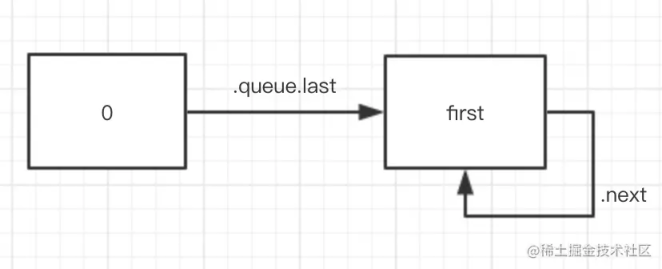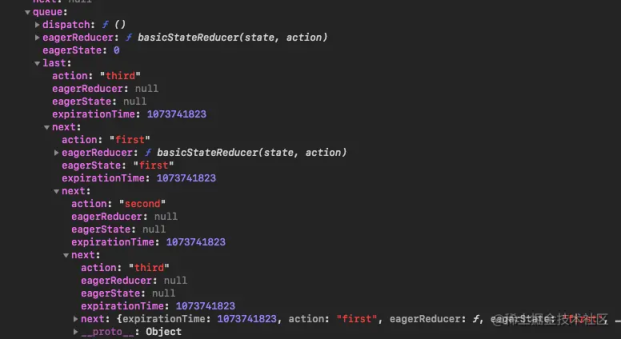前言
简单说下为什么 React 选择函数式组件,主要是 class 组件比较冗余、生命周期函数写法不友好,骚写法多,functional 组件更符合 React 编程思想等等等。更具体的可以拜读 dan 大神的 blog。其中 Function components capture the rendered values 这句十分精辟的道出函数式组件的优势。
但是在 16.8 之前 react 的函数式组件十分羸弱,基本只能作用于纯展示组件,主要因为缺少 state 和生命周期。本人曾经在 hooks 出来前负责过纯函数式的 react 项目,所有状态处理都必须在 reducer 中进行,所有副作用都在 saga 中执行,可以说是十分艰辛的经历了。在 hooks 出来后我在公司的一个小中台项目中使用,落地效果不错,代码量显著减少的同时提升了代码的可读性。因为通过 custom hooks 可以更好地剥离代码结构,不会像以前类组件那样在 cDU 等生命周期堆了一大堆逻辑,在命令式代码和声明式代码中有一个良性的边界。
useState 在 React 中是怎么实现的
Hooks take some getting used to — and especially at the boundary of imperative and declarative code.
如果对 hooks 不太了解的可以先看看这篇文章:前情提要,十分简明的介绍了 hooks 的核心原理,但是我对 useEffect,useRef 等钩子的实现比较好奇,所以开始啃起了源码,下面我会结合源码介绍 useState 的原理。useState 具体逻辑分成三部分:mountState,dispatch, updateState
hook 的结构
首先的是 hooks 的结构,hooks 是挂载在组件 Fiber 结点上 memoizedState 的
//hook的结构export type Hook = { memoizedState: any, //上一次的state baseState: any, //当前state baseUpdate: Update<any, any> | null, // update func queue: UpdateQueue<any, any> | null, //用于缓存多次action next: Hook | null, //链表};
复制代码
renderWithHooks
在 reconciler 中处理函数式组件的函数是 renderWithHooks,其类型是:
renderWithHooks( current: Fiber | null, //当前的fiber结点 workInProgress: Fiber, Component: any, //jsx中用<>调用的函数 props: any, refOrContext: any, nextRenderExpirationTime: ExpirationTime, //需要在什么时候结束): any
复制代码
在 renderWithHooks,核心流程如下:
//从memoizedState中取出hooksnextCurrentHook = current !== null ? current.memoizedState : null; //判断通过有没有hooks判断是mount还是update,两者的函数不同ReactCurrentDispatcher.current = nextCurrentHook === null ? HooksDispatcherOnMount : HooksDispatcherOnUpdate;//执行传入的type函数let children = Component(props, refOrContext);//执行完函数后的dispatcher变成只能调用context的ReactCurrentDispatcher.current = ContextOnlyDispatcher;
return children;
复制代码
useState 构建时流程
mountState
在 HooksDispatcherOnMount 中,useState 调用的是下面的 mountState,作用是创建一个新的 hook 并使用默认值初始化并绑定其触发器,因为 useState 底层是 useReducer,所以数组第二个值返回的是 dispatch。
type BasicStateAction<S> = (S => S) | S;
function mountState<S>( initialState: (() => S) | S,){ const hook = mountWorkInProgressHook();//如果入参是func则会调用,但是不提供参数,带参数的需要包一层 if (typeof initialState === 'function') { initialState = initialState(); }//上一个state和基本(当前)state都初始化 hook.memoizedState = hook.baseState = initialState; const queue = (hook.queue = { last: null, dispatch: null, eagerReducer: basicStateReducer, // useState使用基础reducer eagerState: (initialState: any), });//返回触发器 const dispatch: Dispatch< //useState底层是useReducer,所以type是BasicStateAction (queue.dispatch = (dispatchAction.bind( null, //绑定当前fiber结点和queue ((currentlyRenderingFiber: any): Fiber), queue, ): any)); return [hook.memoizedState, dispatch];}
复制代码
mountWorkInProgressHook
这个函数是 mountState 时调用的构建 hook 的方法,在初始化完毕后会连接到当前 hook.next(如果有的话)
function mountWorkInProgressHook(): Hook { const hook: Hook = { memoizedState: null, baseState: null, queue: null, baseUpdate: null, next: null, }; if (workInProgressHook === null) { // 列表中的第一个hook firstWorkInProgressHook = workInProgressHook = hook; } else { // 添加到列表的末尾 workInProgressHook = workInProgressHook.next = hook; } return workInProgressHook;}
复制代码
dispatch 分发函数
在上面我们提到,useState 底层是 useReducer,所以返回的第二个参数是 dispatch 函数,其中的设计十分巧妙。
假设我们有以下代码:
const [data, setData] = React.useState(0)setData('first')setData('second')setData('third')
复制代码
在第一次 setData 后, hooks 的结构如上图
在第二次 setData 后, hooks 的结构如上图
在第三次 setData 后, hooks 的结构如上图
在正常情况下,是不会在 dispatcher 中触发 reducer 而是将 action 存入 update 中在 updateState 中再执行,但是如果在 react 没有重渲染需求的前提下是会提前计算 state 即 eagerState。作为性能优化的一环。相关参考视频讲解:进入学习
function dispatchAction<S, A>( fiber: Fiber, queue: UpdateQueue<S, A>, action: A,) { const alternate = fiber.alternate; { flushPassiveEffects(); //获取当前时间并计算可用时间 const currentTime = requestCurrentTime(); const expirationTime = computeExpirationForFiber(currentTime, fiber);
const update: Update<S, A> = { expirationTime, action, eagerReducer: null, eagerState: null, next: null, }; //下面的代码就是为了构建queue.last是最新的更新,然后last.next开始是每一次的action // 取出last const last = queue.last; if (last === null) { // 自圆 update.next = update; } else { const first = last.next; if (first !== null) {
update.next = first; } last.next = update; } queue.last = update;
if ( fiber.expirationTime === NoWork && (alternate === null || alternate.expirationTime === NoWork) ) { // 当前队列为空,我们可以在进入render阶段前提前计算出下一个状态。如果新的状态和当前状态相同,则可以退出重渲染 const lastRenderedReducer = queue.lastRenderedReducer; // 上次更新完后的reducer if (lastRenderedReducer !== null) { let prevDispatcher; if (__DEV__) { prevDispatcher = ReactCurrentDispatcher.current; // 暂存dispatcher ReactCurrentDispatcher.current = InvalidNestedHooksDispatcherOnUpdateInDEV; } try { const currentState: S = (queue.lastRenderedState: any); // 计算下次state const eagerState = lastRenderedReducer(currentState, action); // 在update对象中存储预计算的完整状态和reducer,如果在进入render阶段前reducer没有变化那么可以服用eagerState而不用重新再次调用reducer update.eagerReducer = lastRenderedReducer; update.eagerState = eagerState; if (is(eagerState, currentState)) { // 在后续的时间中,如果这个组件因别的原因被重渲染且在那时reducer更变后,仍有可能重建这次更新 return; } } catch (error) { // Suppress the error. It will throw again in the render phase. } finally { if (__DEV__) { ReactCurrentDispatcher.current = prevDispatcher; } } } } scheduleWork(fiber, expirationTime); }}
复制代码
useState 更新时流程
updateReducer
因为 useState 底层是 useReducer,所以在更新时的流程(即重渲染组件后)是调用 updateReducer 的。
function updateState<S>( initialState: (() => S) | S,): [S, Dispatch<BasicStateAction<S>>] { return updateReducer(basicStateReducer, (initialState: any));}
复制代码
所以其 reducer 十分简单
function basicStateReducer<S>(state: S, action: BasicStateAction<S>): S { return typeof action === 'function' ? action(state) : action;}
复制代码
我们先把复杂情况抛开,跑通 updateReducer 流程
function updateReducer( reducer: (S, A) => S, initialArg: I, init?: I => S,){ // 获取当前hook,queue const hook = updateWorkInProgressHook(); const queue = hook.queue;
queue.lastRenderedReducer = reducer;
// action队列的最后一个更新 const last = queue.last; // 最后一个更新是基本状态 const baseUpdate = hook.baseUpdate; const baseState = hook.baseState;
// 找到第一个没处理的更新 let first; if (baseUpdate !== null) { if (last !== null) { // 第一次更新时,队列是一个自圆queue.last.next = queue.first。当第一次update提交后,baseUpdate不再为空即可跳出队列 last.next = null; } first = baseUpdate.next; } else { first = last !== null ? last.next : null; } if (first !== null) { let newState = baseState; let newBaseState = null; let newBaseUpdate = null; let prevUpdate = baseUpdate; let update = first; let didSkip = false; do { const updateExpirationTime = update.expirationTime; if (updateExpirationTime < renderExpirationTime) { // 优先级不足,跳过这次更新,如果这是第一次跳过更新,上一个update/state是newBaseupdate/state if (!didSkip) { didSkip = true; newBaseUpdate = prevUpdate; newBaseState = newState; } // 更新优先级 if (updateExpirationTime > remainingExpirationTime) { remainingExpirationTime = updateExpirationTime; } } else { // 处理更新 if (update.eagerReducer === reducer) { // 如果更新被提前处理了且reducer跟当前reducer匹配,可以复用eagerState newState = ((update.eagerState: any): S); } else { // 循环调用reducer const action = update.action; newState = reducer(newState, action); } } prevUpdate = update; update = update.next; } while (update !== null && update !== first);
if (!didSkip) { newBaseUpdate = prevUpdate; newBaseState = newState; }
// 只有在前后state变了才会标记 if (!is(newState, hook.memoizedState)) { markWorkInProgressReceivedUpdate(); } hook.memoizedState = newState; hook.baseUpdate = newBaseUpdate; hook.baseState = newBaseState; queue.lastRenderedState = newState; }
const dispatch: Dispatch<A> = (queue.dispatch: any); return [hook.memoizedState, dispatch];}
复制代码
export function markWorkInProgressReceivedUpdate() { didReceiveUpdate = true;}
复制代码
后记
作为系列的第一篇文章,我选择了最常用的 hooks 开始,抛开提前计算及与 react-reconciler 的互动,整个流程是十分清晰易懂的。mount 的时候构建钩子,触发 dispatch 时按序插入 update。updateState 的时候再按序触发 reducer。可以说就是一个简单的 redux。














评论